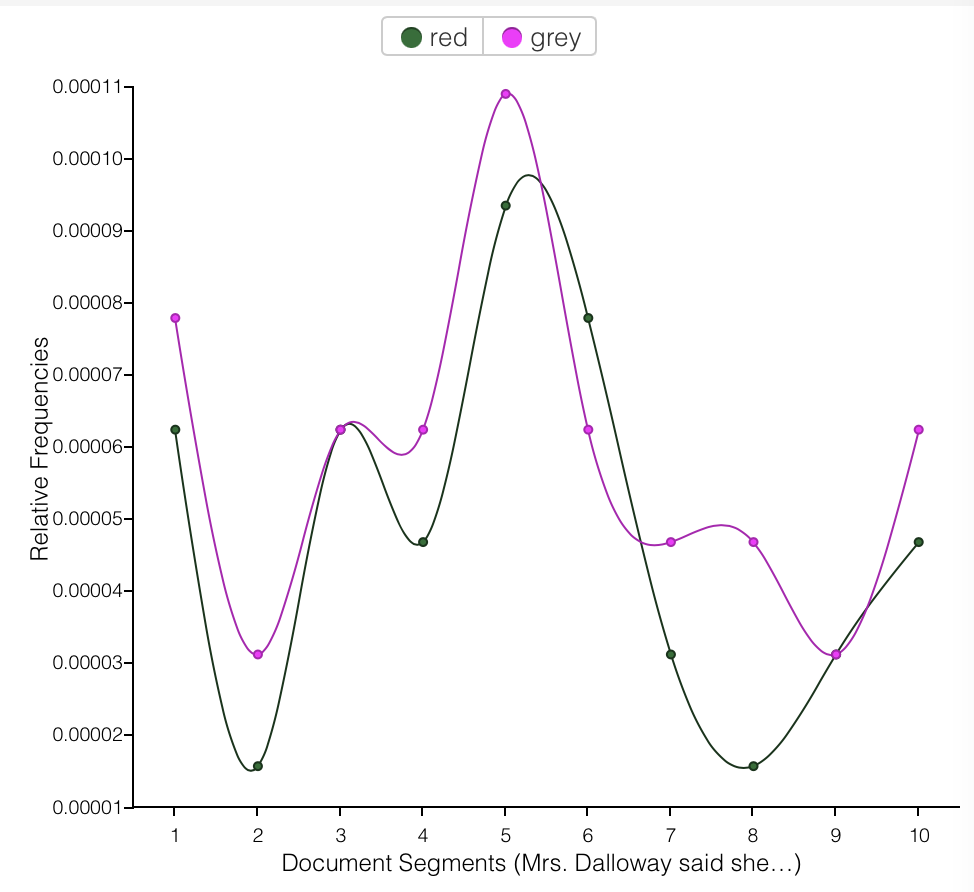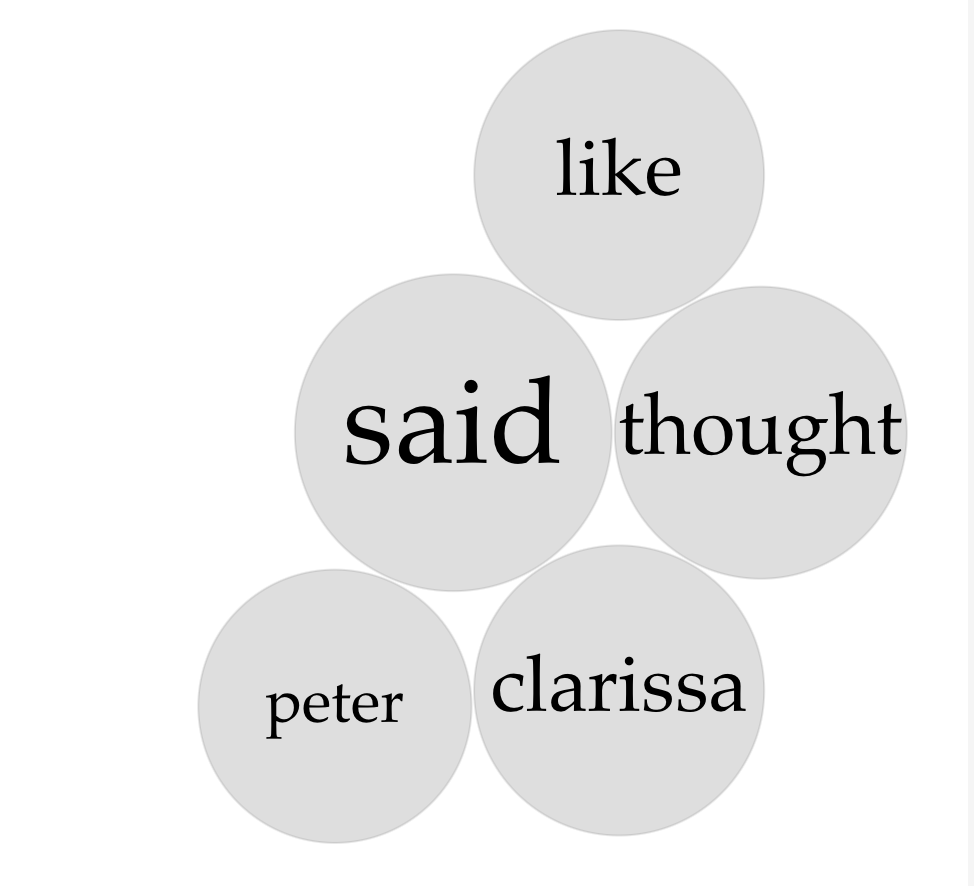Comparing Close and Distant reading outcomes of Virginia Woolf’s Mrs. Dalloway.
For the text analysis praxis, I chose to test out an observation made while close reading Virginia Woolf’s Mrs. Dalloway. For another DH class, I’ve been working on a group project investigating annotation methods using the Mrs. Dalloway as the basis. Despite Woolf suggesting that she simply let the novel flow through her with no great structure in mind, when reading it’s hard to not feel the seemingly concrete structure on top of which flows the seemingly meandering stream of consciousness dance. Of course that stream of consciousness surfaces themes again and again via the minds of various characters until it becomes plain that Woolf wants us to explore certain aspects of our humanity—youth and age, spontaneity and duty among them.
When close reading I felt and remarked that the color grey turned out repeatedly. At first I suspected that the London setting and widely accepted stereotypical assumptions of English weather made me more attuned it (ahh yes, confirmation of that stereotype, I’m picturing the right thing) —maybe even made me overestimate its prevelance. But then I began to notice it being applied to all manner of things—but most often in a manner to denote stature, wisdom, age, and respectability. I also began to nice the mention of roses—a kind of sprinkling evenly throughout the text in relationship to various characters. These flowers were derided, gifted, and displayed—even used by Septimus, a character with a tenuous connection to this Earth, to ground himself in the moment and counteract his tendency lose himself to incoherent thought. I decided that Voyant would be a great way to see what the algorithm’s had to say about my observations. Would the reinforced or minimized—would it help suss out a pattern I didn’t observe?
Looking at the frequency of grey (38 mentions), which appears more than any other color in the text after white (58 mentions), I did see a continued usage throughout the text, and the context revealed what I had suspected. It is often used to denote age (grey hair)—and suggest a more regular and fixed time of life. It is, also, used to signal a more refined air—standing in the world. In relation to the text, I’d even go so far as to say it showcased the kind of fixed and respectable striving of 1923 London. Weather does come in, for sure (grey-blue sky), but more often it describes the appearance of understated and refined clothing, vehicles, and homes of established ladies and gentlemen.
Indeed it was—Sir William Bradshaw’s motor car; low, powerful, grey with plain initials’ interlocked on the panel, as if the pomps of heraldry were incongruous, this man beingthe ghostly helper, the priest of science; and, as the motor car was grey, so to match its sober suavity, grey furs, silver grey rugs were heaped in it, to keep her ladyship warm while she waited.
He had worked very hard; he had won his position by sheer ability (being the son of a shopkeeper); loved his profession; made a fine figurehead at ceremonies and spoke well—all of which had by the time he was knighted given him a heavy look, a weary look (the stream of patients being so incessant, the responsibilities and privileges of his profession so onerous), which weariness, together with his grey hairs, increased the extraordinary distinction of his presence and gave him the reputation (of the utmost importance in dealing with nerve cases) not merely of lightning skill, and almost infallible accuracy in diagnosis but of sympathy; tact; understanding of the human soul.

In considering roses, I wondered if it might not be more congruous, given my investigation of the color grey, to shift to investigating the color red. The roses mentioned throughout the book are red—that classic color of love, emotion, youth and intensity. When I made this adjustment something very striking was revealed. The frequency of the mention of red mirrored that of grey—almost as though they went hand in hand. Instead of black and white, Woolf seemed to have leaned into a contrast of grey and red—old vs young, passion vs resignation.

The striking overlap is even more apparent when contrasted with the color most mentioned in the book— white. There is a clear correlation between grey and red.


Investigating red’s term berry doesn’t give too much away, but digging into the context gives everything away. It’s often mentioned in descriptions with almost riotous abundance of color (in stark contrast to drab and monotonous grey) and often paired with descriptions of flowers and bodily features (again with hair and clothing, but also nostrils, lips, and cheeks). Red is seemingly used to the character experience in the present moment of the novel in contrast to the experience of reminiscence that makes up much of the novel.
… and it was the moment between six and seven when every flower—roses, carnations,
irises, lilac—glows; white, violet, red, deep orange; every flower seems toburn by
itself, softly, purely in the misty beds; and how she loved the grey-white mothsspinning
in and out, over the cherry pie, over the evening primroses!
But she’s not married; she’s young; quite young, thought Peter, the red carnation he had seen her wear as she came across Trafalgar Square burning again in his eyes and making her lips red.
…through all the commodities of the world, perishable and permanent, hams, drugs, flowers, stationery, variously smelling, now sweet, now sour she lurched; saw herself thus lurching with her hat askew, very red in the face, full length in a looking-glass; and at last came out into the street.
And that very handsome, very self-possessed young woman was Elizabeth,over there, by the curtains, in red.
Over all this investigation made me curious about mapping and investigating the many many overlapping patterns and structures in the novel. In fact, this exercise and that in my other class has pushed me into a peculiar space of looking at the novel as a specimen to be poked, prodded, and labeled, graphed and displayed. In this way I might possess and express my own experience of it. The idea of thinking one could “master” a novel in this way feels a bit like a delusion. It’s like trying to create a bot of Woolf’s thought process, but when you press go she doesn’t pass the Turing test. I know that there is value to this work—and as I become more comfortable and perhaps apply these tools to non-fiction work as well I can better manage the dissonance that flutters about this exercise.
BONUS:
If you haven’t read Mrs. Dalloway, setting the Voyant Terms Berry to the smallest word sample gives a pretty good summary:




